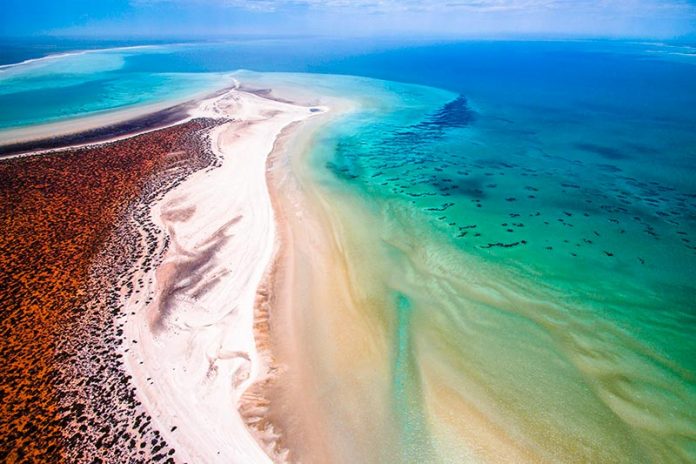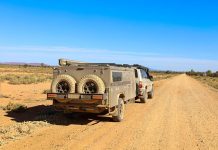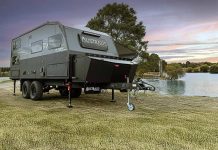To be considered for listing as a World Heritage site, a region or property must meet at least one of four criteria of ‘universal value’. Shark Bay, sprawling over 23,000 square kilometres, with both land and marine features of great significance, meets all four criteria.
The bay fans out around the end of Peron Peninsula, which is sandwiched between Disappointment Reach and Freycinet Reach. Along the west coast lies another peninsula, and immediately north is Dirk Hartog Island. This is a ‘W’ of heath-draped land surrounded by luminous blue water that throbs with a variety of land and marine flora and fauna, some of it brought back from the brink of extinction by strict conservation programs such as Project Eden and Return to 1616. Given how much there is to explore, it is helpful to allow plenty of time at Shark Bay.
HAMELIN POOL
Hamelin Pool Marine Nature Reserve makes a good first stop. Here, where tidal flows are restricted and the rate of water evaporation is high, the water salinity is twice that of seawater. This hyper-saline ecosystem makes it difficult for marine organisms to survive. Still, a few microbes – with a lineage reaching back 1900 million years – have flourished, massing together in dense colonies of 3000 million microbes per square metre.
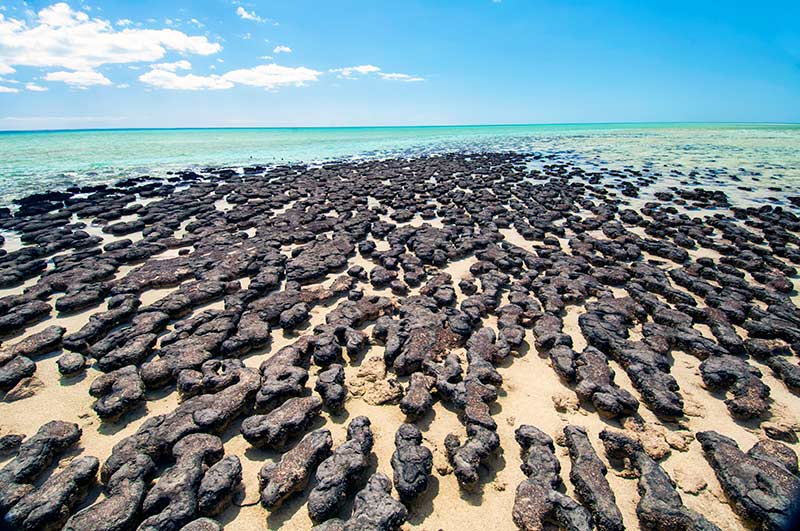
These are stromatolites and are often described as the oldest living organisms on earth, which is misleading. It would be more accurate to say they are related to, or descended from, the oldest organisms on earth. The Hamelin Pool stromatolites are, in fact, about 2000 to 3000 years old, growing at a rate of about 5cm each century. Fossilised stromatolites in the Pilbara region of Western Australia are dated to 3500 million years, and the microbes that built them are the first living organisms on earth. Two thousand million years later, evolution began when two microbes merged to form a single cell with an internal organisation. How cool is that?
In the past, one could simply wade in the water amongst the stromatolites, and sit or walk on them. Thankfully, they are now protected, and a boardwalk allows visitors to view the stromatolites without harming them. (Due to damage from Cyclone Seroja, the boardwalk is currently closed, scheduled to be rebuilt in 2023. For further information, check the Parks & Wildlife Service website for alerts or phone [08] 9948 2226.)
Also in the Hamelin Bay area is the historic Old Telegraph Station, which opened in 1884. Here, one can see where the ground of tiny, solidified shells, compacted over centuries, has been quarried into blocks and used as building bricks. Many of the homesteads in the area were made from these shell bricks, though this practice has stopped for conservation reasons.
The Hamelin Bay Caravan Park is a pleasant place to spend a night or two, especially once the boardwalk is open again. Their homemade scones with jam and cream are a treat worth trying!
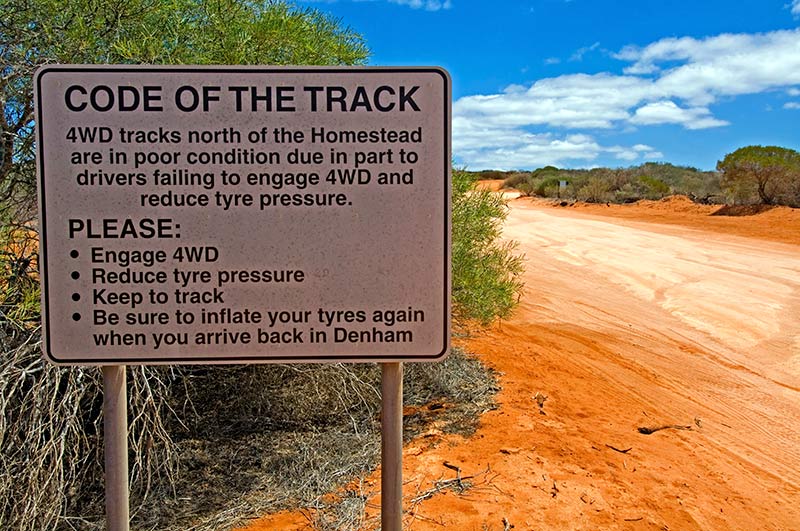
There are two ways to explore Shark Bay: you can take the easy, sealed road reaching along the east coast of the marine park from Hamlin to Denham and then across to Monkey Mia, and/or you can take the challenging way west of Hamlin to Edel Land National Park (proposed), Dirk Hartog Island National Park and/or Francois Peron National Park north of Denham.
All three parks require a 4WD with high clearance, recovery gear and an air-compressor to re-inflate tyres. Be fully prepared with all supplies; tents or single-axle offroad camper trailers only. Note that while some maps indicate there is camping and caravan storage at Tamara Station, this facility is closed for the foreseeable future; the same applies for Carrarang Station.
You can leave a van behind at Hamelin Pool Caravan Park or Hamelin Outback Station Stay. Expect 140km of unsealed road with 30km of a single-lane track through sand dunes leading to the highlights of Edel and Steep Point (the most westerly point in Australia). You will need to reduce your tyre pressure at the same place you pay your park entry fee. Download the pdf files for each park and pay particular attention to the safety recommendations and the map. For in-depth 4WD information download 4WDriving Shark Bay; also visit 4wdingaustralia.com and 4-wheeling-in-western-australia.com.
DIRK HARTOG ISLAND NP
It would be a shame to go all that way and not proceed a bit further to Dirk Hartog Island National Park. There are several camping and accommodation options, which must be booked through Dirk Hartog Island Lodge; they also operate the small barge to the west of the Edel ranger’s house. Bookings are required in advance.
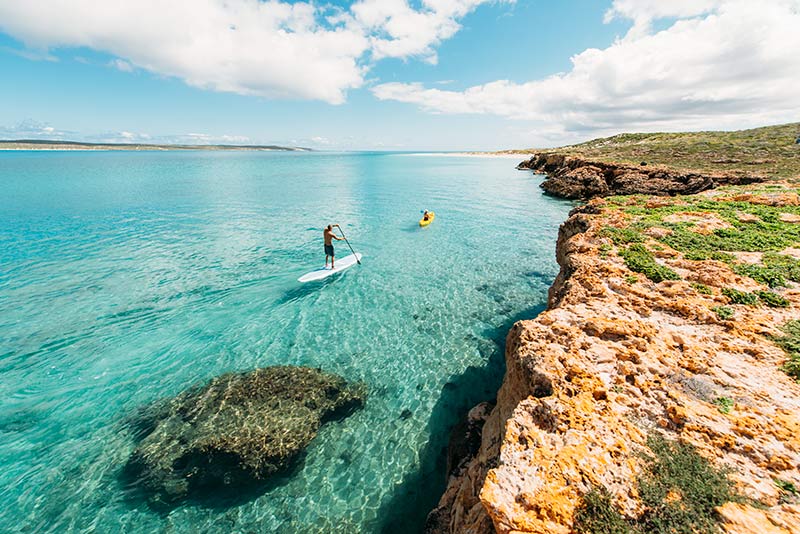
Have a thorough look through the island lodge website; this will give you an excellent idea of what to expect and which campground would suit you best.
Sadly, I have never been to this part of Shark Bay, but the next time I am there, I fully intend to take advantage of the Day at Dirk Island Life Adventures operating out of Denham.
On your way back from your 4WD adventures, you might want to spend a few nights at Nanga Bay Resort on sealed Shark Bay Road. This caravan park sits on the shore of the eastern edge of Shark Bay Marine Park, and while the term ‘resort’ involves a touch of hyperbole, it remains a nice park that gives you the chance to relax on a beach with satin-smooth waters, soak in the artesian spa and catch-up on a few chores.
A short 10km along is Shell Beach: most certainly worth a look. It is at this narrow neck at the start of Peron Peninsula that Project Eden began. Not only is Shark Bay blessed with marine life, the land also abounds with some of Australia’s rarest mammals and birds. Tragically, much of Shark Bay’s native wildlife had been decimated by introduced species.
A project to remove vermin, and reintroduce natives, began in the mid-1990s. A barrier fence was erected across the narrow isthmus, and 50,000 fox baits were set down in one year alone. Traps were set for cats, with 1455 cats caught in 1996. Malleefowl, rufous hare-wallabies, western barred bandicoots, bilbies, greater stick-nest rats and the adorable Shark Bay mouse were reintroduced to the area. All in all, the project has been successful.
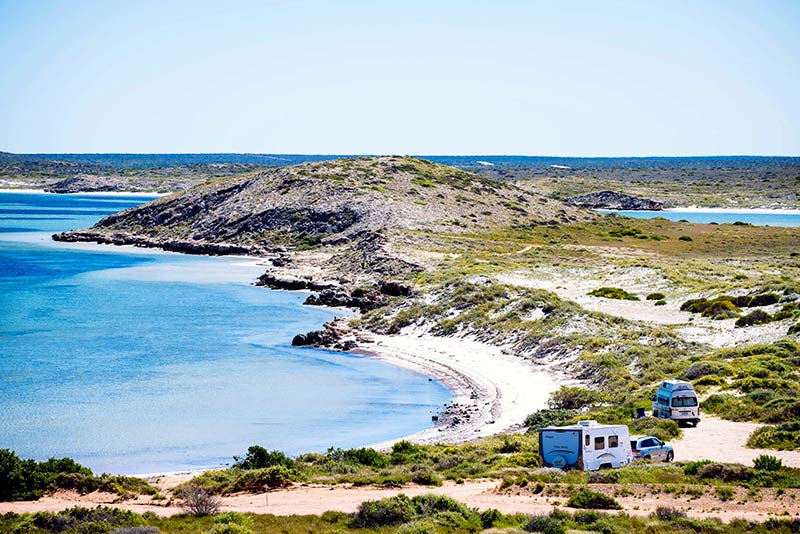
Continuing north toward Denham, there are several worthwhile stops with beachside campgrounds at Whalebone and Fowler’s Camp followed by a lookout at Eagle Bluff. The campgrounds require a $15 entry permit, there are no facilities, and you may only stay at a single site for 24 hours.
Denham gives you more options for longer stays. From here, you can catch that day trip to Dirk Hartog Island. You can also spend the better part of a morning or afternoon at Ocean Park, a large aquarium with a variety of local marine life including, of course, sharks. Smaller tanks also include some of the locals. 4WD tours, dive tours and boat tours can be booked through the park; check the website for more information or ask at the Shark Bay World Heritage Discovery and Visitor Centre.
RV accommodation in Denham includes the Shark Bay Caravan Park (they offer caravan storage) and the Denham Seaside Caravan Park.
FRANCOIS PERON NP
If you are a 4WD glutton, we have saved the best for last. Francois Peron National Park is dazzling, but again, it requires a high-clearance 4WD with sand recovery gear and an air-compressor. You may tow a single-axle offroad camper trailer or a dingy; caravans are not permitted. Bring all supplies with you; you can stock up at Denham’s two food stores (don’t forget plenty of water).
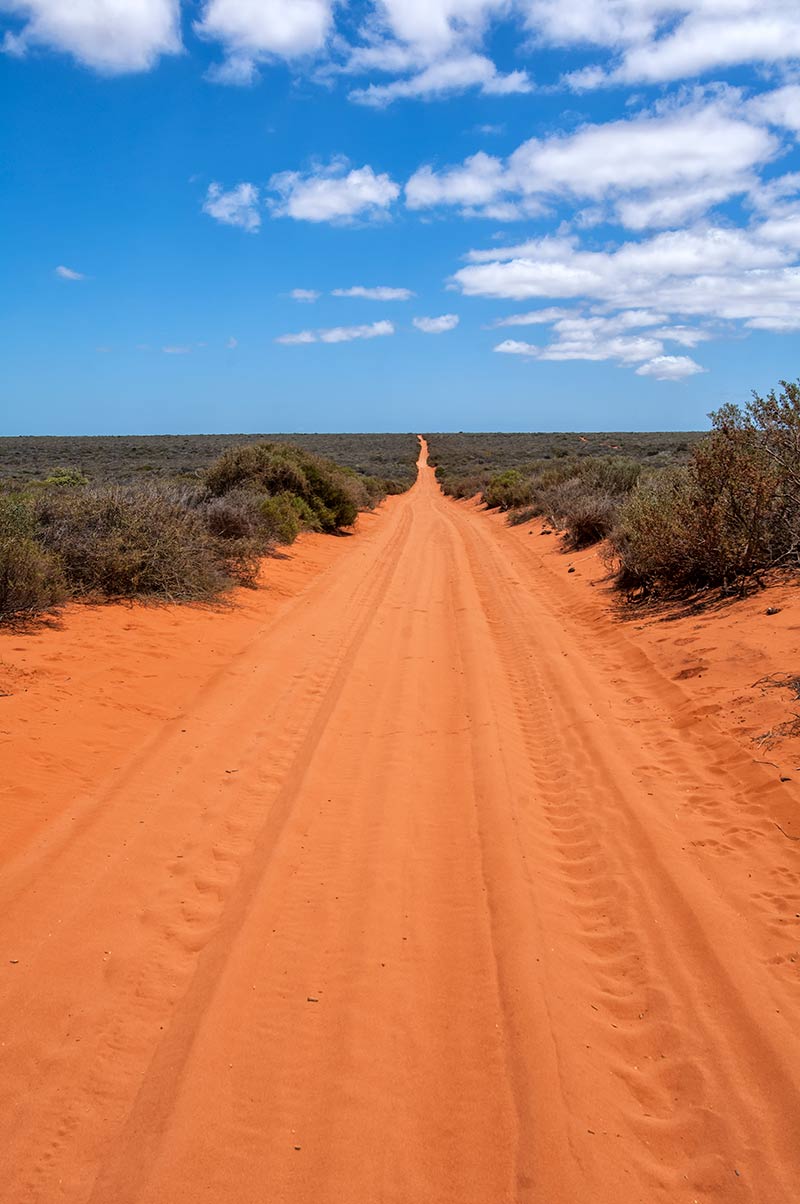
If you prefer a guided tour, a full-day adventure is on offer. From the start of the red sandy track reaching north to Cape Peron, to stunning Skipjack Point, to the five campgrounds, this park is nothing short of superb. Check the park brochure for details, and our GoRV article on Francois Peron National Park. If you have a sea kayak with you, you might want to try the 38km (return) Big Lagoon Paddle Trail at the Big Lagoon Campground. If you make it up to Skipjack Point, the 3.6km (return) Wanamalu Trail to Cape Peron is a scenic highlight of the park.
MONKEY MIA
While not all people are familiar with the varied attractions of Shark Bay, almost everyone has heard of Monkey Mia. This sits halfway along the eastern edge of the Peron Peninsula and is famous worldwide for its wild dolphins. In the 1960s, several fishermen began feeding a dolphin named Old Charlie, so the story goes. Other dolphins heard about the free fish and began to gather around boats, along the jetty, and eventually near the beach to be hand-fed fish.
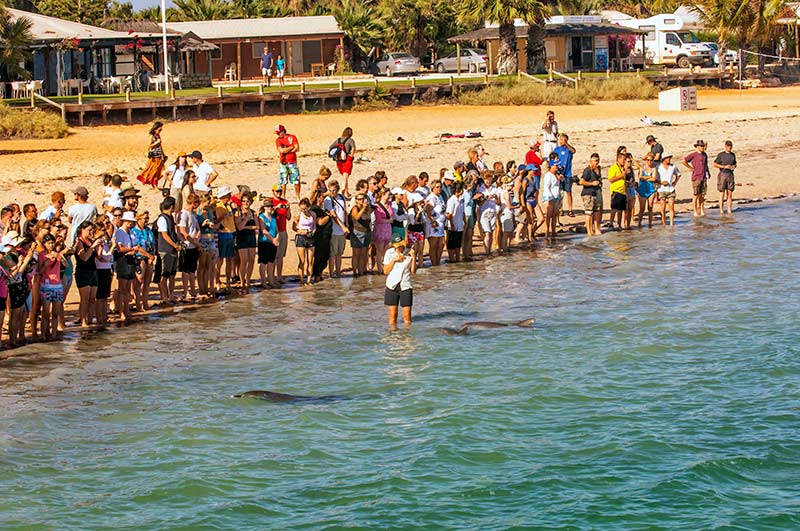
The marine biology department of an American university found out about these dolphins and, in 1982, sent a couple of graduate students out to study them. The six or seven dolphins who visited fishermen at Monkey Mia formed a fraction of the 300 dolphins living in the area and thus began The Shark Bay Dolphin Project that continues to this day.
When we first went to Monkey Mia in 1984, one reached it via a 150km-long pothole-ridden, axle-cracking, rock-strewn, nerve-shattering corrugated track. There was a shanty caravan park catering to fishermen. There were no powered campsites, and the showers were saltwater-only. You pitched your tent near a curving sliver of ivory sand that separated the red earth from the blue sea. In those days, a crowd would have been 20 people. It was a peaceful, gorgeous paradise until it got itself discovered.
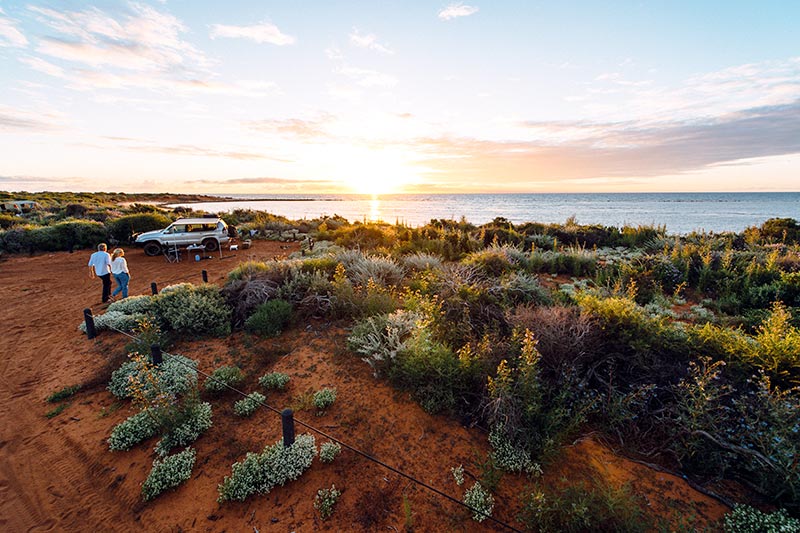
Eventually, the road was paved, the area was declared the Monkey Mia Conservation Park, day tours drove up from Perth, and after several accommodation incarnations, the RAC Monkey Mia Dolphin Resort (with camping) stepped in. Like so many things, it is no longer as peaceful as it was, but it is certainly still gorgeous. Visitors line up every morning to watch the dolphins being fed under the strict control of a ranger. Pelicans waddle along the beach, sharing fish with the fishermen. Dolphins swim close to shore, leisurely coming up for air with a satisfying exhale. The sand is heavy and soft, the water is still and beautiful. When the sun sets, it turns the bay to scarlet satin.
Aside from watching dolphins, there are walks to do along the shoreline, both to the north and the south, along with the 2.7km Wulyibidi Yaninyina Trail loop. Get that kayak off the roof, launch your tinny, rent a paddleboard or just gaze in wonder at the scenery.
If you are boat-less but still want to get out on the water, Wildsights offers marine-life viewing tours from the Monkey Mia pier on their sailing catamaran. With the most expansive meadows of diverse seagrass species on planet earth, Shark Bay supports a stunning diversity of marine-life and there is no better way to observe this than by boat.
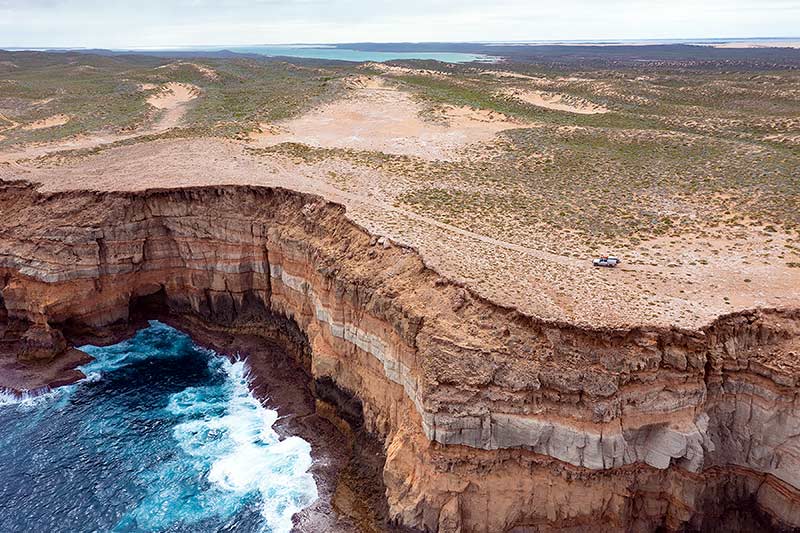
These waters are home to about 10,000 dugongs, 10 per cent of the world’s total population. There are over 2000 dolphins; this includes the 300 Monkey Mia dolphins. Six thousand marine turtles (green turtles and loggerheads) also thrive on the seagrass meadows.
Shark Bay is not called Shark Bay without reason: there are at least 28 shark species. Manta rays, along with other ray species, frequent the bay. On our most recent boat tour, a Wildsights crew member climbed up the main mast of the sailboat, looking out with binoculars and shouting directions to the skipper. We found dugongs, numerous dolphins who the crew knew by name, green turtles, stingrays, a few tiger sharks and even a sea snake coming up for air. A sunset cruise was thrown in for free, and who would want to miss that?
It seems that every time we are driving on the North West Coastal Highway, even if the plan is to skip Shark Bay this time, as soon as we reach the Overlander Roadhouse we are drawn west, and we immediately decide to return to our favourite places in Shark Bay. This is such a special place and I, for one, will never get tired of exploring it. Shark Bay: a World Heritage Site it most certainly is.
Images: Steven David Miller / Natural Wanders
MAPS
- Shark Bay World Heritage Map
- Shark Bay Visitor Map
- Dirk Hartog Island Map (Interactive)
- Dirk Hartog Island Campground & Driving Track Map
- Edel Land & Steep Point
- Francois Peron National Park Map
SHARK BAY HERITAGE AND VISITOR INFORMATION
- World Heritage Status
- World Heritage Universal Value
- The Shark Bay Dolphin Project
- Visitor Information
- Shark Bay Marine Reserves Visitor Guide pdf
- Monkey Mia Marine & Boating Guide
NATIONAL PARKS
- Parks & Wildlife Service, Shark Bay District, Knights Terrace, Denham, (08) 9948 2226.
- Steep Point Ranger Station, (08) 9948 3993, UHF channel 16, VHF channel 16.
- National Park Entry Fees (paid upon entry)
- National Park Camping Fees (booked in advance)
- Dirk Hartog Island Return to 1616
TIPS
- Stock up with groceries at Carnarvon to the north or Geraldton to the south. The only grocery stores in Shark Bay are in the town of Denham.
- Be sure to bring sturdy, thick-souled waterproof shoes for wading in the shallows, and use them! Stonefish and cone snails are found throughout Shark Bay, and they are highly venomous. Contact the Shark Bay Health Centre on (08) 9948 1400 right away if you are stung by one.


